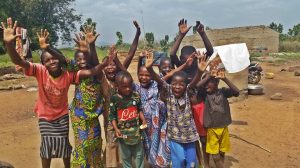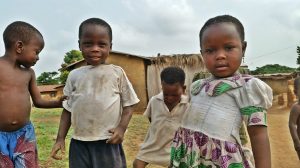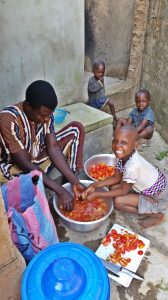This project is made possible through the partnership of WATER CHARITY and the NATIONAL PEACE CORPS ASSOCIATION. ![]()
Check out the #video below!
Location
This project summary has been redacted for security reasons to omit the specific project location.
Awaya, Dassa-Zoume Communé, Collines Department, Benin
Community Description
Dassa-Zoumé is a city in Benin, on the Cotonou to Parakou railway and the main north-south highway. The commune covers an area of 1711 square kilometers and as of 2013 had a population of 112,118
 Gxxxxx and Axxxx are two neighboring villages located in the city, in the Collines department of south-central Benin. They lie two kilometers apart from each other and are connected by a dirt road. There are 5 schools in total: a kindergarten and primary school in each village, and a secondary school that serves both communities.
Gxxxxx and Axxxx are two neighboring villages located in the city, in the Collines department of south-central Benin. They lie two kilometers apart from each other and are connected by a dirt road. There are 5 schools in total: a kindergarten and primary school in each village, and a secondary school that serves both communities.
Recently, electricity was brought to Gxxxxx. However, the residents of Axxxx still live without this luxury. These two villages are comprised of approximately 2,200 inhabitants, the majority of whom are cultivators and vendors.
The primary language spoken is Mahi and about 20% of the population also speak French.
Problem Addressed
The inhabitants of Gxxxxx and Axxxx are in need of a reliable and safe water source. This need can be further defined on two levels: in the school community, and within the residential community.
 At the moment, there is no access to water on or near the 5 school campuses located within Axxxx- Gxxxxx. This causes health concerns related to the inability to wash hands after using the restroom or before eating, and staying hydrated. Additionally, the lack of a nearby water source limits the school’s ability to develop a school garden. As a result, the students, and staff members at these schools are at compromising their health, which in turn impacts their attendance and performance at school.
At the moment, there is no access to water on or near the 5 school campuses located within Axxxx- Gxxxxx. This causes health concerns related to the inability to wash hands after using the restroom or before eating, and staying hydrated. Additionally, the lack of a nearby water source limits the school’s ability to develop a school garden. As a result, the students, and staff members at these schools are at compromising their health, which in turn impacts their attendance and performance at school.
Within the residential community, villagers rely on open wells dug throughout the community. This again results in a series of health risks including waterborne diseases and related illnesses. Furthermore, during the dry season of December through May, the water supply from these wells is exhausted. Villagers, primarily young girls, are forced to walk long distances to the nearest pump to retrieve water for their families to drink, prepare food, wash dishes, do laundry, and bathe. These pumps are often overcrowded as villagers must wait in line for their turn at the pump. During the dry season, which coincides with the school year, young girls spend around 12 hours each week fetching water instead of studying and doing homework.
 Project Description
Project Description
This project will restore the existing water tower that serves the villages of Gxxxxx and Axxxx by connecting it to the nearby electrical system.
Until recently, the water tower was powered by a gas generator that frequently required maintenance. Two years ago, the generator broke, rendering the water tower unusable.
With access to this new, more reliable power source, water will be delivered to the existing water taps dispersed throughout the two villages and at each of the five schools. The water provided by these taps will be cleaner and more conveniently located than the current system of wells and pumps. This option is more cost-effective and sustainable than replacing the existing generator.
First, the community members will construct a shelter to house a 30-amp three-phase transformer that will source electricity from the power line access point, located next to the primary school of Gxxxxx. Then, the community will clear a path, 1.5 km long and 5 meters wide, leading from the primary school of Gxxxxx to the water tower pump located in Axxxx. Then, 80 teak wood poles will be installed to support and elevate the 1,700 meters of SBEE electric cables. An electrician will be hired to connect the electric wires to the transformer in Gxxxxx and to the water tower pump in Axxxx.
The chiefs of villages are managing the overall project and mobilizing the efforts of the community, which is committed to the success of this project. The members are prepared to contribute the labor necessary to clear a path connecting the water tower and transformer, as well as provide the labor needed to install the 80 teak poles. This community contribution equates to 25% of the total project cost.
Funds from Water Charity will be used to purchase the materials and pay for transportation costs and the skilled labor of the electrician
Project Impact
This project will serve all of the 2,200 inhabitants of the two villages.
 Peace Corps Volunteer Directing Project
Peace Corps Volunteer Directing Project
L. Murray
Monitoring and Maintenance
The completion of this project will be a significant step in making the water tower more sustainable. By replacing the expensive gas generator, which required frequent maintenance, with a more cost-effective and reliable energy source, less upkeep will be required to keep the water tower operating.
In order to cover electricity costs and necessary repairs, representatives from each village will regulate the water taps and charge a small nominal fee for their usage.
Additionally, each year community members will clear and maintain the path of the newly installed power lines to avoid trees and undergrowth interfering with the electrical connection.
Let Girls Learn
This project will have a large impact on empowering girls to stay in school. Due to the gender roles of Benin’s culture, household chores, including fetching water, are deemed as the responsibility of girls.
During the dry season, which coincides with the school year, the wells run dry and young girls are forced to walk further distances and wait in lines at overcrowded pumps to find water. On average, young girls spend 10 to 12 hours a week fetching water for their family instead of studying their school lessons.
By reducing the amount of time young girls spend fetching water, we can increase the amount of time they can devote to their school work, and further compete with their male classmates.
Fundraising Target
$4,900
Funds raised in excess of the project amount will be allocated to other projects in the country.
Donations Collected to Date
$800
ADOPT THIS PROJECT BY CONTRIBUTING THE DOLLAR AMOUNT OF THE PROJECT
Donations of any amount will be appreciated. The full amount will give you “naming rights”, if that is something you would like.
Dollar Amount Needed
$4,100